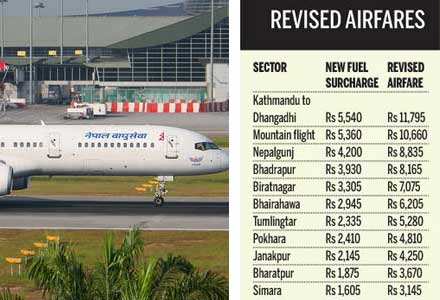

Airlines jack up surcharge after fuel price hike

Domestic airlines did not wait long to jack up the fuel surcharge after Friday’s hike in aviation fuel prices by Nepal Oil Corporation (NOC). On Monday, the carriers raised the fuel surcharge by Rs 65 to Rs 235. Airlines are allowed to increase the fuel surcharge when fuel prices rise by Rs 4 or more per litre.
As per NOC’s latest tariff, aviation fuel became dearer by Rs 6 and now costs Rs 143 per litre. The state-owned oil monopoly, which routinely cites “mounting losses” for its price hikes, makes a profit of Rs 33.33 per litre of aviation fuel sold to domestic carriers.
As per the revised fuel surcharge, a one-way ticket on the longest domestic route Kathmandu-Dhangadhi costs Rs 11,795, while an air ticket on the shortest route Kathmandu-Simara costs Rs 3,145. The fuel surcharge on a ticket to Dhangadhi amounts to Rs 5,540.
“Frequent hikes in fuel prices have became a headache for domestic operators as they have made fares so expensive that it has become unaffordable for Nepali fliers,” said Prajwol Thapa, senior marketing manager of Simrik Airlines.
“As fuel accounts for 30-40 percent of an airline’s operating costs, we have no option but to pass on the extra burden to travellers.”
Similarly, Roshan Regmi, marketing manager of Yeti Airlines, said, “The hike is nominal, but it could create an impact on traveller movement. However, it’s too early to say what the impact of the hike will be.”
DOUBLE WHAMMY
Airfares on domestic sectors have soared more than 40 percent in less than three years. Fuel surcharges have been revised more than six times during the period.
Airlines said that things were not looking so good for domestic operators as many of them are struggling to survive in the market. According to them, there are two major challenges for them at present-rising fuel costs and the directive by the European Commission (EC) to European travellers not to fly Nepali carriers.
Swelling airfares have been affecting airline occupancy since the EC’s decision is likely to affect the domestic airlines market from this year, they said. On Dec 5, 2013, the EC blacklisted Nepali carriers for their poor safety record. It has also told European travellers not to fly on any of them.
According to Tribhuvan International Airport statistics, domestic airlines received 47,299 less flyers in the first nine months (January-September) of 2013 compared to the same period a year ago largely due to increased airfares. Domestic air traveller movement dropped 4.11 percent to 1.10 million during the review period.
“The upward revision of fuel surcharges has again put airlines under pressure,” said Thapa. For example, the normal airfare on the Kathmandu-Bhadrapur sector has jumped from Rs 6,275 in 2011 to Rs 8,165 presently. Likewise, the airfare on the Dhangadhi sector has gone up from Rs 9,234 to Rs 11,795.
“Meanwhile, the market has also started facing the repercussions of the EC’s ban,” Thapa added. Operators said that at a time when airlines had been witnessing a reduced number of domestic travellers, tourist movement has also started to decline since mid-January.
Although, arrivals from China have increased significantly, they are reluctant to fly Nepali airlines. Industry insiders said that frequent air crashes could be the reason behind their unwillingness to fly in Nepal.
source:the kathmandu post,19 march 2014








